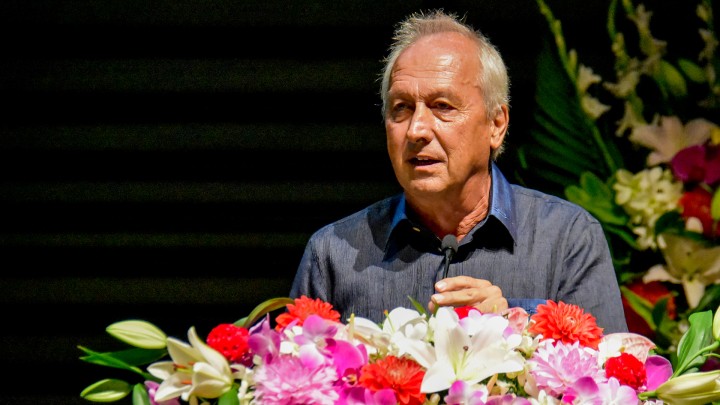Welcome to the 8th Class of OIST Graduate Students

Thank you all for joining me today. Your work at OIST will help shape the future of humanity. The nature of our life on this planet – and beyond – is in your hands.
This is, of course, a humongous task, but I don’t think it is an overstatement because never before have we had to face such radical change in technologies making a colossal impact on all of us. This world is changing so rapidly that the famed historian Yuval Noah Harari proclaimed in his global best-seller “Sapiens: A Brief History of Humankind” that “in 100 or 200 years the Earth will be dominated by people that resemble todays human beings as much as we now resemble Neanderthals or Chimpanzees.”
You might be thinking that Harari is exaggerating, just a little, for dramatic effect. But the years ahead seem set to change what it means to be human. Influential technologies are already prompting paradigm change; a shift from an anatomic to causal view of medicine will disrupt our healthcare industry over the coming decade and make a substantial impact on what it means to be human.
Artificial Intelligence and advanced robotics will disrupt our workforce, testing the very idea of what it means to be human. Digital technologies bring many benefits, but their vulnerability to cybersecurity threats will become more pronounced as we deliver advances in quantum computing.
And these technologies are intertwined with privacy and human rights issues. Already, some governments use AI and facial recognition technologies for surveillance with both positive and negative ramifications. Imagine what would happen in the future if we do not consider the legal, moral and ethical implications of new technologies today?
A rapidly changing world is also confronted by grand challenges: climate change, providing energy and clean water, coping with global population mobility and increasing urbanization. These are all complex and all require collaboration across sectors and expertise. Interdisciplinary basic research is the key to solving these challenges, and OIST is unique in providing such interdisciplinary research.
It is not often that one encounters a university as unique as OIST – just as it is not often that new universities are built from scratch. But it is even more exceptional for a university to make advances so rapidly, in such a short period of time. So far OIST’s development has been pretty successful. Others say it. Nature Index, for example, has ranked OIST #1 in Japan and #9 in the world in terms of scientific quality. This is no fluke. OIST was founded on the principles of becoming a world-leading university.
Just like my previous institution, the Max Planck in Germany, OIST provides high-trust funding to our research units. Instead of grant funding that is mostly written to support mainstream projects, we fund our scientists ourselves and with this encourage them to be creative and take risks in their research.
I always use the saying: fund people, not projects. This is how you cultivate excellence. Every university has its purpose, and ours is to deliver research, education and technology transfer of the highest quality to Okinawa, Japan and the world. Using this purpose as our guide, we have committed ourselves to recruiting only the most talented, brilliant, and creative students, researchers, faculty and administrators.
With gaining international recognition, our pool of applications per position has been rising year by year. In the past year alone, we had over 1,500 applications, for 10 faculty positions. More than 900 talented men and women applied for the 54 graduate student positions in which 46 we are welcoming today. People from every corner of the world, and from prestigious institutions, applied to us. And, needless to say, we selected only the best to come to OIST. We are proud to have you. But we also expect a lot from you: from your own journey, and from the journey of our young university.
My advice to you at the beginning of your journey I’ve summarized as the five C’s of success:
- Be curious. Albert Einstein once said: “I have no special talent. I am just passionately curious”.
- Be creative. Creativity is the process of having original ideas that have value.
- Be courageous. Don’t accept a trodden path.
- Be critical. Do not accept mediocrity in yourself, your science, or your staff.
- Complete projects. Work to an end, write it up and move on.
Make the most of every single thing that OIST can offer you, because OIST will provide you with opportunities you simply could not find anywhere else. Every month, for example, we hold a Presidential Lecture featuring a world-renowned scientist. Visitors include Nobel Laureates, globally renowned research leaders, and some of the most influential brains at work in the world today. We also welcome distinguished speakers to special workshops and events – people like Ben Feringa, Steven Chu, Paul Nurse, Christiane Nuesslein-Volhard (all Nobel Prize winners) and Svante Paabo the founding father of palaeogenetics.
One of the many beauties of OIST is that we are small enough that anyone can interact easily with our invited speakers -- not just faculty or senior administrators. To have students connecting directly with Nobel Laureates and other leaders in their field – not just chatting, but sharing ideas, posing questions – is something you simply do not encounter at most university campuses on a regular basis.
I advise – indeed, I expect – you to take advantage of this opportunity and rare privilege. I believe your work and your understanding of our world will be much better for it. Great science arises where there are no boundaries but strong networks. Scientific breakthroughs happen at the borders of disciplines.
Our small size will allow you to build a strong network of peers. And, in my experience, the most creative people are connected with their best peers. Look to your left and right, in front and behind you. It is almost guaranteed that the people you meet here will continue to do great things in their lifetime. So, I invite you – our 8th Class – to be the Class which contributes unmatched levels of energy, enthusiasm and time to transdisciplinary education. I challenge you – our 8th Class – to impress our Scientists and our distinguished speakers with your curiosity, your hunger for insight, your willingness to question, and your openness to people and perspectives.
I want us to see more of one another at many of these lectures, and look forward to that. OIST is already proving itself in terms of scientific excellence – but this needs to happen every day if we seek to fulfill the dreams of our founders and become the best university in the world.
All of us, the university administration, and you, our body of scientists, can do more. We can leverage our scientific success, to better support the sustainable development of Okinawa. This can be done in several ways: first and foremost, through our research. We already have an array of research projects which can directly benefit Okinawa: from Okinawan art conservation, to fire ant surveillance, to the preservation of the coral reefs. Recently, a new prototype of the wave energy converter was installed just off the coast of Seragaki by Prof. Tsumoru Shintake’s team. This will help bring more sustainable energy to Okinawa.
I am immensely proud of these projects and encourage each of you to bear in mind a possible application, if your project allows it. Remember who funds your work. As scientists, we like to think we give back to the public through our intellectual contributions, publications or solutions to the numerous challenges that the world is facing. But we should contribute in other ways too.
Education and community outreach are vital components of Okinawa’s long-term development. In this room are some of the best and the brightest students and scientists of their generation. It is your responsibility to help nurture your own successors. We have many longstanding community outreach events which you can support. You will have a wonderful time, I promise, participating in the Onna-OIST Children’s School of Science, which has just celebrated its 10th anniversary; or at our Science Festival, held every November; or by taking part in our regular science trips to remote islands. These programs are led by our Community Relations team in the Communications and Public Relations Division, and they are always looking for participants.
I am also impressed by so many of the student-led initiatives benefiting our local community, including the Okinawa Science Mentoring Program, Nerd Nite Okinawa, and the ECO Club’s events and festivals. I hope that each and everyone one of you become involved in at least one of these programs, or create your own outreach event for others to participate in. And you should not let any language barrier deter you from sharing your science with our neighbors. You can learn Japanese or you can partner with someone who is already fluent. Remember: life at OIST, and in science, is not a solo endeavor.
We have a great responsibility to share our science with others through publications and presentations; but we have an even greater duty to share our science with the public at large. So, I look forward to the continuing development of OIST’s digital and media profile, and to ever-deeper engagement with government, industry, our research and university peers, and our community. You will all be part of that.
A new Vice President for Communication and Public Relations, Jonathan Ray, has joined OIST today. Jonathan comes to us via the BBC and executive communication roles in research universities, recently at KAUST and then Oxford. I know he hopes to meet as many of you as possible and learn about your work and interests.
As well as Jonathan there are two other members of my team formally to welcome: our recently appointed Vice President for Human Resources, Ms. Tomo Nagase, worked previously with IBM across Asia and brings deep understanding of management and organizational development, and concern for engagement, diversity, and making sure that our community feels motivated by the work it carries out each day. And, not here today but also happily on board, is Dr. Masayuki Shibata, who took up the position of Vice President for Financial Management a few months ago. Dr Shibata served most recently as Executive Vice President for Finance and Facility Development and Secretary-General at the Tokyo Institute of Technology. He brings a wealth of experience gained within government in Japan and overseas.
Additionally, Prof. Tadashi Yamamoto head of the “Cell Signal Unit” has been serving as the Dean of Research since April. His immense research network in Japan and abroad makes him particularly suited to excel in this position.
At this point I would also like to take the opportunity to introduce Prof. Jeff Wickens as our ombudsman and in case of conflict of interest Prof. Evan Economo as the Deputy Ombudsman. OIST has established this Ombuds Office to ensure that all employees and students have a safe environment in which to voice questions and concerns and to provide constructive alternatives to the existing channels by which employees and students can assert their rights and interests and seek resolution of problems and conflicts.
Every one of my colleagues in the OIST administration is here to support your work and study and help create the conditions for success. This is what motivates us. We are each here to create opportunities for all of you to excel and to make a difference.
Technology Transfer is an integral part of the OIST mission, and our VP and Vice-CEO in charge of it, Dr. Bob Baughman, with his Associate VP Lauren Ha, has been working hard to provide a curriculum for the training and education of our scientists to become entrepreneurs. The goal is to promote technology transfer and innovation, to revitalize the local economy, and attract more high-tech industries, and well-paying jobs, to Okinawa. This will require a two-pronged approach: supporting technology transfer of OIST research; and bringing to our campus the most promising startups alongside established industry partners.
The first part is already being done: we have a thriving proof of concept program that some of you in the audience may have already participated in. Now, we are working on attracting industry partners, in order gradually to build an innovation ecosystem at OIST. Spanning all that we do is a new Strategic Plan for OIST with Ken Peach and Cecilia Lu as the driving forces behind it. This was recently finalized. It articulates ambitious goals – and how we can best achieve them – for the next decade and beyond.
The planning process has taken more than a year, with students, faculty, administrators and other staff all coming together in the form of Task Forces to make contributions. Thank you to all of you who contributed time, energy and ideas. We will publish the full Strategic Plan after the Board of Governors Meeting next month, and I encourage all of you all to read it. But I can summarize some key points now.
In two years’ time – just 10 years after coming into existence as a University – we expect to have 100 faculty conducting research and educating students here at OIST. A decade later, we should reach 200 faculty. This means more than doubling our current size of about one thousand staff. And more faculty will mean more researchers, more students in the labs, and suitable numbers of administrators to support them. To accommodate all of this we will need more buildings, more equipment, more housing, and expanded facilities.
We also understand that many of our people will want to bring their families to Okinawa, which calls for an appropriate K-12 school, and expanded daycare to accommodate their children. As we grow, so will Onna-son and Tancha village. We are not separate entities. We want to grow together, supporting one another’s development. Part of my job as President is to reach out to local and national government and find ways in which we can work and benefit together. I will continue to meet with local and national politicians in the years ahead to enable this.
South of us, towards Naha, lies Shuri-jo castle. When Okinawa was the independent Ryukyu Kingdom, Shuri-jo was the heart of it. Inside the castle is a bell: “Bangkoku shinryo no kane”: the “Bridge to all Nations” Bell”. As part of the Ryukyu Kingdom, Okinawa connected the world as a major trading port. Today, OIST is bridging all nations with science. Look around you. You – our students, our faculty and staff from all over the globe, are here to exchange ideas, and create new knowledge and technology that will benefit humanity and help all to master the tremendous challenges that lie ahead.
As Louis Pasteur said: “Science knows no country, because knowledge belongs to humanity, and is the torch which illuminates the world.” I warmly welcome all of you to OIST.














